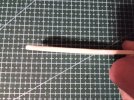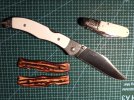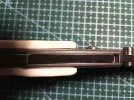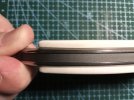Alex.Y.
Gold Member
- Joined
- Jan 11, 2021
- Messages
- 1,826
I think that question belongs here, as bone is a traditional handle material.
So, I made a bone scales to replace the delrin ones, but one of the slabs had a slight curve, as does the cover now. I wonder if that can be cured by something else than grinding? Heating maybe (I guess not)?
I plan to just screw it tight to the handle thus eliminate the bend (already works with pressing to the flat surface by hands), but I am afraid that this kind of constant tension will lead to a massive crack at some point.
I know there are many experienced knifemakers here, so I seek your advice. Thanks in advance!


So, I made a bone scales to replace the delrin ones, but one of the slabs had a slight curve, as does the cover now. I wonder if that can be cured by something else than grinding? Heating maybe (I guess not)?
I plan to just screw it tight to the handle thus eliminate the bend (already works with pressing to the flat surface by hands), but I am afraid that this kind of constant tension will lead to a massive crack at some point.
I know there are many experienced knifemakers here, so I seek your advice. Thanks in advance!


Last edited:






